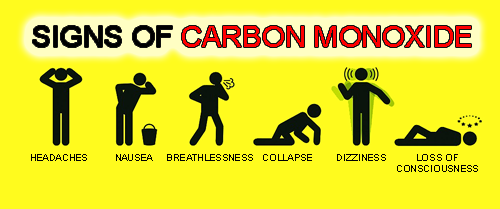
Piston powered aircraft produce high concentrations of CO and, by design, carry the highest risk that CO can enter the cabin during flight. This can occur both on the ground and in-flight. Poorly designed and/or maintained aircraft, as well as damaged aircraft can result in CO, and other gases, entering the cabin and flight deck either directly or via the air-conditioning system. positioned in front whilst taxiing or waiting for departure) can enter unfiltered via the bleed air and air-conditioning system. It is also possible that exhaust gases from other aircraft (e.g. Whilst on the ground, CO produced externally to an aircraft can enter cabins and flight decks via open doors and hatches.

CO will also be created from combustion of materials during an aircraft emergency involving fire. Although odourless and tasteless, CO produced from these sources will usually be mixed with other, compounds, gases and vapours that can be detected through smell and taste. In aviation the most typical sources of CO are exhaust from: internal combustion engines (piston-driven aircraft, airside vehicles and ground servicing equipment) aircraft turbine engine exhaust and, Auxiliary Power Unit (APU) exhaust. A good example of this is the case of Doctor Robert Frayser who awoke only after his Comanche had ran out of fuel and crashed into a field he thought he was still in the air ! Sources of Carbon Monoxide in Aviation This is a problem because the pilots most at risk from CO poisoning are those flying small piston-powered aircraft, solo. However, like Hypoxia many of the symptoms of CO poisoning will make it difficult, if not impossible, to self-diagnose. Onset of drowsiness can be very swift, and unless action is taken immediately to decrease exposure and reverse the concentration of CO in the blood (see below), sleep followed by unconsciousness will be inevitable. Typical symptoms of carbon Monoxide poisoning It is important for everyone to be aware of the “onset” symptoms of CO poisoning these are summarised in the following Table. Therefore, exposure to relatively small amounts of CO, for many, can increase health risks. Smokers will have raised CO levels of between 20 and 40 ppm. Most healthy people will have existing levels of CO in their blood between 0 and 10 ppm this can vary greatly depending on exposure to (for example) inner city road traffic and poorly maintained domestic appliances. Occupational Safety and Health Administration (OSHA) defines two limits for unhealthy CO exposure: an upper limit of 100 parts per million (ppm) in unventilated spaces and, an average exposure over 8 hours of 55 ppm.

CO also reacts, chemically, with other proteins and enzymes in the blood which can lead to damage to the brain, heart and nervous system. In this respect, the symptoms are very similar to Hypoxia. This has a direct affect on the performance of those parts of our physiology that rely on Oxygen for proper functioning. When inhaled CO is absorbed easily into the bloodstream where it attaches itself to haemoglobin with an affinity over 200 times that of Oxygen.
:max_bytes(150000):strip_icc()/what-is-carbon-monoxide-Final-27d97041ac95424c9af73c0dd25adcad.jpg)
For example, in the UK alone: 50 people die, 200 people are hospitalised and 4,000 admitted to Accident & Emergency units annually, due to CO poisoning. Known as the “silent killer”, poisoning from CO is responsible for more than 400 deaths per annum in the USA and a similar number in Europe these are typically in industrial and domestic situations. Prolonged and repeat exposures at lower concentrations can lead to the same conclusions.ĬO is a colourless, odourless and tasteless gas, and is a by-product of the incomplete combustion of carbon-containing materials. doi:10.1371/ Monoxide (CO) is a highly poisonous gas and exposure can quickly lead to short-term symptoms, long-term health issues, and even death.

Lack of Pupil Reflex and Loss of Consciousness Predict 30-Day Neurological Sequelae in Patients with Carbon Monoxide Poisoning. Zou J, Guo Q, Shao H, Li B, Du Y, & Liu M. Characteristics of Children with Acute Carbon Monoxide Poisoning in Ankara: A Single Centre Experience. Unsal Sac R, Taşar M, Bostancı İ, Şimşek Y, & Bilge Dallar Y. Archives Of Environmental & Occupational Health. Two Storm-Related Carbon Monoxide Poisoning Outbreaks-Connecticut, October 2011 and October 2012. Styles T, Przysiecki P, Archambault G, Sosa L, Toal B, Magri J, & Cartter M. Carbon Monoxide-Induced Cardiomyopathy.Circulation Journal. Jung Y, Lee J, Min Y, Park J, Jeon W, & Park, E. Risk of Peripheral Artery Disease in Patients With Carbon Monoxide Poisoning. Chen Y, Lin T, Dai M, Lin C, Hung Y, Huang W, & Kao C.


 0 kommentar(er)
0 kommentar(er)
